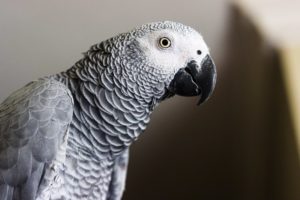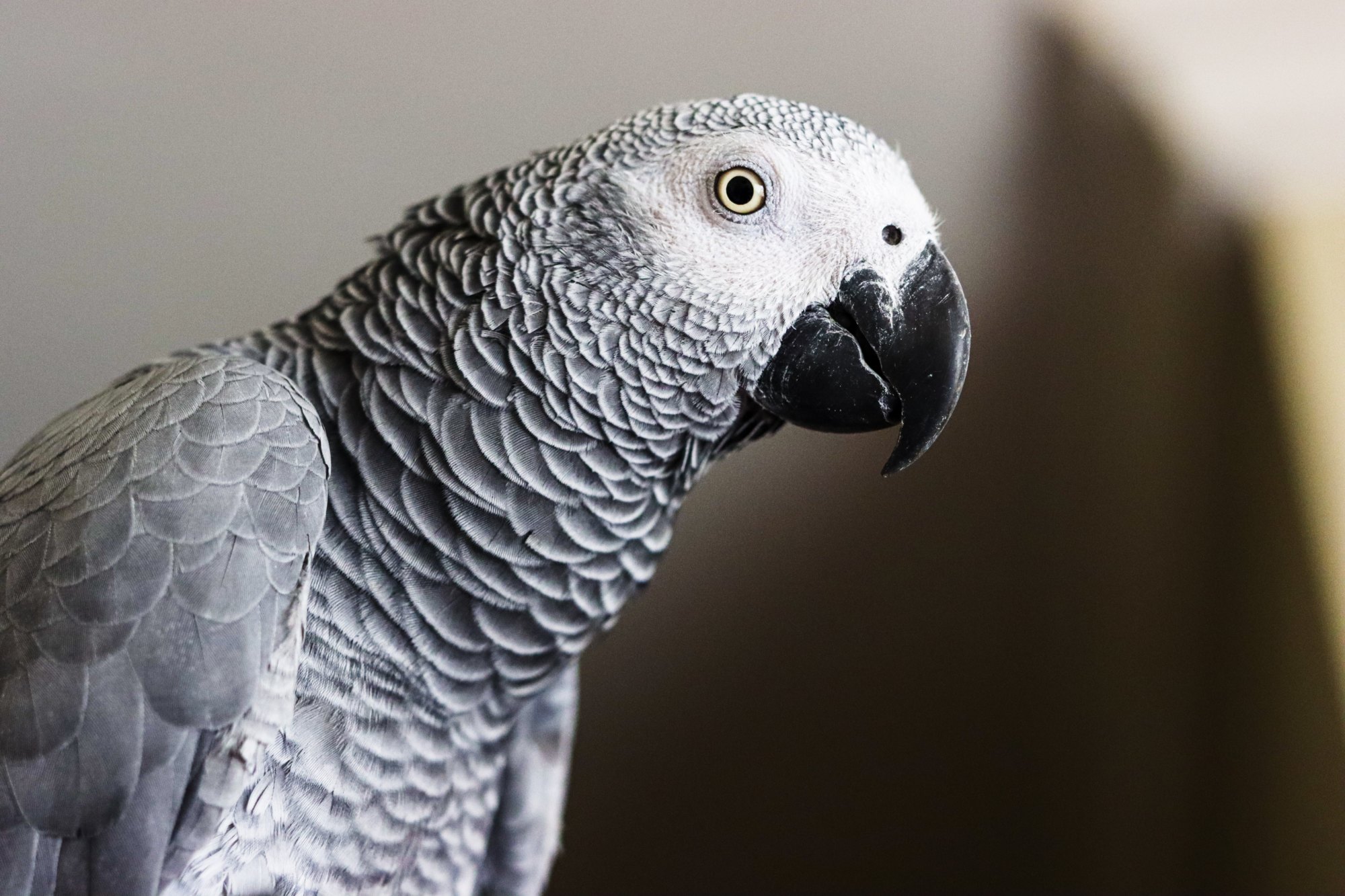
Recently, I was asked to present a Plenary talk at an international bioacoustics conference. Given that I hadn’t studied bioacoustics in over twenty-five years, and that the research on which the published papers were based—on how parrots produce human speech—was primarily performed by undergraduate and graduate students in my laboratory, I was a bit concerned and asked the organizer if I could present at least some of my more recent work on parrot cognition. He agreed but made it clear that the reason he invited me was to remind colleagues of my earlier research so that it might inspire additional studies with more advanced equipment. That made me think that readers of this blog might also be interested….
A Complex Production
What is fascinating about how African grey parrots produce human speech is not only that they can do it at all, but also that they don’t do it the same way as do humans, and that different parrots (individuals and species) often do it in different ways as well. For starters, think about how humans need their lips for what are called “plosives”—consonants like /p/ and /b/.
Also think about the huge differences in how we configure the various parts of what is called our “vocal tract” (all the anatomical bits involved; more about that later) when we produce even simple vowels, like /a/ (as in “pasta”) or /i/ (as in “bee”). [Say the words aloud and you’ll see what I mean! Note that I am using the notation of the International Phonetic Alphabet, the standard way to transcribe human speech. It may be a bit confusing at first but is a system that allows all languages to be described.] Some parrots “cheat” a bit and use whistles that to our ears sound like speech, but actually is very different from speech, whereas others like Alex actually manage to produce speech that, when analyzed, looks very much like that of humans (see Pepperberg, 2007 and Fig 1 below).
The Human Vocal Tract
So, a very brief description of human speech, and then more about parrots who sound like humans. When humans speak, the initial sound is produced in the larynx, a hollow tube in the middle of the neck, just above the trachea (the windpipe, connecting the lungs and larynx) and behind the esophagus (the tube that leads from your mouth to your stomach). The larynx—the human sound source—contains what are called vocal cords, membranes that close together and vibrate as air that is expelled from the lungs passes between them.
The vibration of the larynx is mostly responsible for what is called the fundamental frequency or formant F0 in human speech (note that a structure called the glottis also has some effect on the production of the sound, but not as much as the vocal cords). The sound then is further shaped by parts of the mouth—predominantly the tongue (whether it moves toward the front or back of the mouth, or up towards or down from the palate), the opening or closing of the mouth, and the placement of the lips. (Other bits—such as the nasal cavities—are involved, but not as strongly). The mouth and tongue thus predominately affect the next two formant frequencies, F1 and F2. All vowels can be described by the set formed by the frequencies of these formants—i.e., each vowel has a unique combination. Consonants are also characterized by something called “voice onset time” (VOT), which is the time between air being release from the trachea and vocal cord vibration; so, for example, the consonants in /pa/ (“pah”) versus /ba/ (“bah”) are distinguished in part by their different VOTs.
Consonants are also affected by the sounds that follow, so the /k/ in “key” is a bit different from the /k/ in “corn” [Again, try saying the words and you’ll see what I mean.] The fancy term for that distinction is anticipatory co-articulation. It basically reflects our understanding that the vocal tract is able to change in myriad ways to produce all the sounds of human speech.
The Parrot Vocal Tract


 Parrots have a very different system (see Patterson & Pepperberg, 1994, 1998). Their sound source is not their larynx, but rather their syrinx—a set of muscles at the base of their trachea, essentially connecting their lungs and trachea. When they produce true (rather than whistled) human speech, the vibration of these muscles produce the F0. The sound then travels up the trachea, which is only somewhat flexible, and the change in the trachea as each vowel is produced results in its characteristic F1. The sound then goes up through the avian glottis, which has a slit called the avian larynx; these organs affect the sound somewhat for each vowel, but (as in humans) not nearly as much as do the tongue and beak.
Parrots have a very different system (see Patterson & Pepperberg, 1994, 1998). Their sound source is not their larynx, but rather their syrinx—a set of muscles at the base of their trachea, essentially connecting their lungs and trachea. When they produce true (rather than whistled) human speech, the vibration of these muscles produce the F0. The sound then travels up the trachea, which is only somewhat flexible, and the change in the trachea as each vowel is produced results in its characteristic F1. The sound then goes up through the avian glottis, which has a slit called the avian larynx; these organs affect the sound somewhat for each vowel, but (as in humans) not nearly as much as do the tongue and beak.
The African grey parrot tongue moves back and forth quite a bit depending on the vowel produced, but not as much up and down as does the human tongue. Beak opening in African grey parrots is just as important as is mouth opening in humans. The positions of the tongue and beak in combination produce the F2 values. So, just as for humans, the combination of formants are unique for each vowel produced by an African grey parrot (see Fig 2).
Notably, without lips, African greys have trouble with consonants such as /p/ and /b/—but all their consonants still have unique VOTs. They seem to use their esophagus to “burp” some of these consonants (see Pepperberg et al., 1997; Warren et al., 1996), just as humans who have had a laryngectomy. And birds like Alex also demonstrate anticipatory co-articulation, even though their vocal tracts are quite different from those of humans.
The actual production of speech—both in African grey parrots and humans—is quite a bit more complex than the brief description I’ve provided here; the referenced papers provide far more information. My goal was simply to provide an overview that gives at least some idea of what is involved, and to note some of what is both the same and different in human and Grey parrot productions.
So, the next time you listen to a parrot use human speech, think about all the effort that is involved—the bird has to learn to control all these different parts of its vocal tract in ways that are quite different from how it produces its normal squawks and whistles!
References:
Patterson, D.K. & Pepperberg, I.M. (1994). A comparative study of human and parrot phonation: Acoustic and articulatory correlates of vowels. JASA. 96, 634‑648.
Patterson, D.K. & Pepperberg, I.M. (1998). A comparative study of human and Grey parrot phonation: Acoustic and articulatory correlates of stop consonants. JASA, 103, 2197-2213.
Patterson, D.K., Pepperberg, I.M., Story, B.H. & Hoffman, E. (1997). How parrots talk: Insights based on CT scans, image processing, and mathematical models. In SPIE Proceedings, Vol. 3033; ed. E. Hoffman. International Society for Optical Engineering.
Pepperberg, I.M. (2007). Grey parrots do not always ‘parrot’: Phonological awareness and the creation of new labels from existing vocalizations. Language Sciences, 29, 1-13.
Warren, D.K., Patterson, D.K., & Pepperberg, I.M. (1996). Mechanisms of American English vowel production in a Grey Parrot (Psittacus erithacus). Auk, 113, 41-58.

4 Comments